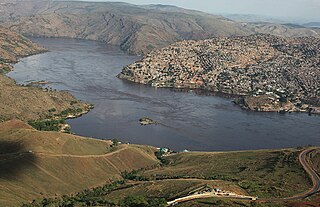
Matadi is the chief sea port of the Democratic Republic of the Congo and the capital of the Kongo Central province, adjacent to the border with Angola. It had a population of 245,862 (2004). Matadi is situated on the left bank of the Congo River, 148 km (92 mi) from the mouth and 8 km (5.0 mi) below the last navigable point before the rapids that make the river impassable for a long stretch upriver. It was founded by Sir Henry Morton Stanley in 1879.

Lobito is a municipality in Angola. Located in the Benguela Province, on the Atlantic Coast north of Catumbela Estuary. Lobito municipality had a population of 393,079 in 2014.

Kolwezi or Kolwesi is the capital city of Lualaba Province in the south of the Democratic Republic of the Congo, west of Likasi. It is home to an airport and a railway to Lubumbashi. Just outside of Kolwezi there is the static inverter plant of the HVDC Inga-Shaba. The population is approximately 573,000.

Kananga, formerly known as Luluabourg or Luluaburg, is the capital city of the Kasai-Central Province in the Democratic Republic of the Congo and was the capital of the former Kasaï-Occidental Province. It is the fourth most populous urban area in the country, with an estimated population of 1,458,000 in 2020.

The Benguela Railway is a Cape gauge railway line that runs through Angola from west to east, being the largest and most important modal of the type in the country. It also connects to Tenke in Democratic Republic of the Congo, to the Cape to Cairo Railway.
The Beira Railroad Corporation or CCFB is a railway company formed by a lease from the Mozambique Ports and Railways (CFM) to the Indian Rites and Ircon International consortium to operate a railroad that originates from the port of Beira, Mozambique as a terminal. The 1,067 mmCape gauge Beira line is important as it provides port access for landlocked states such as Zimbabwe, Malawi, Zambia, and the Democratic Republic of the Congo's Katanga Province.
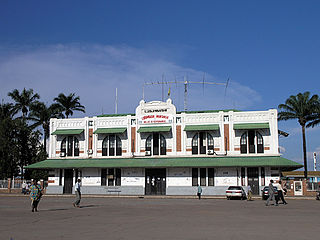
The Société Nationale des chemins de fer du Congo is the national railway company for the inland railways of the Democratic Republic of the Congo.
Luau is a town and municipality in Angola in the province of Moxico on the border with the Democratic Republic of Congo.
Rail transport in Zambia is primarily provided by two systems:

Rail transport in Angola consists of three separate Cape gauge lines that do not connect: the northern Luanda Railway, the central Benguela Railway, and the southern Moçâmedes Railway (southern). The lines each connect the Atlantic coast to the interior of the country. A fourth system once linked Gunza and Gabala but is no longer operational.

Rail transport in the Democratic Republic of the Congo is provided by the National Railway Company of the Congo, the ONATRA and the Office of the Uele Railways.
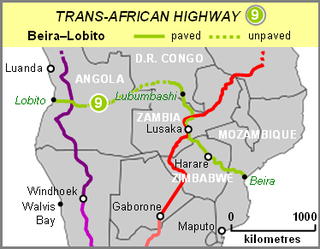
The Beira–Lobito Highway is Trans-African Highway 9 in the transcontinental road network being developed by the United Nations Economic Commission for Africa (UNECA), the African Development Bank (ADB), and the African Union. The route has a length of 3,523 km (2,189 mi) crossing Angola, the most southerly part of the Democratic Republic of the Congo, Zambia, Zimbabwe, and central Mozambique.

Railway stations in Angola include:
Divuma is a town in the Lualaba province of the Democratic Republic of the Congo, near the border with Zambia.

Tenke is a town in the Lualaba province of the Democratic Republic of the Congo.
Dilolo is a town in Lualaba province, Democratic Republic of the Congo. It lies within five miles of the eastern bank of the Luao River, the DRC-Angolan border, and the Angolan town of Luau, at an altitude of 3510 ft.
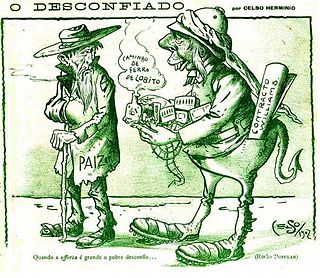
The history of rail transport in Angola began during the nineteenth century, when Angola was a colony of Portugal. It has involved the construction, operation and destruction of four separate, unconnected, coast-to-inland systems, in two different gauges. Operations on three of those systems have been largely restored; the other system has been closed.
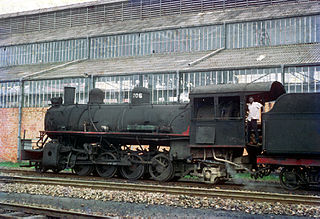
The Compagnie du chemin de fer du bas-Congo au Katanga (BCK) was a railway operator in the Congo Free State, Belgian Congo and later in the Democratic Republic of the Congo and Zaire. Most of the lines were in the southern Katanga Province, with links to the Kasai River for transport of mineral exports down to Kinshasa and onward to the port of Matadi, and a link to the Angolan railway network for transport to Lobito on the Atlantic.
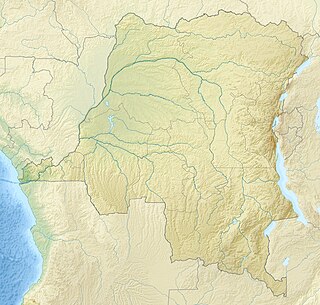
The Luao River is a river that forms part of the boundary between Angola and the Democratic Republic of the Congo. It is a right tributary of the Kasai River.
The following lists events that happened during 1929 in the Belgian Congo.
This page is based on this
Wikipedia article Text is available under the
CC BY-SA 4.0 license; additional terms may apply.
Images, videos and audio are available under their respective licenses.












